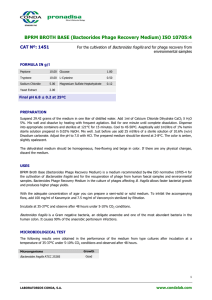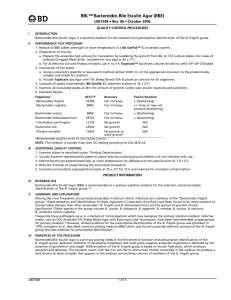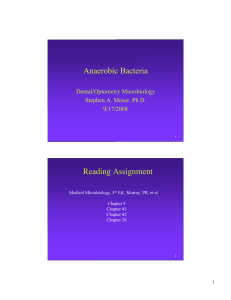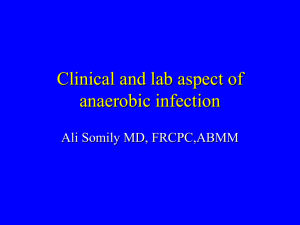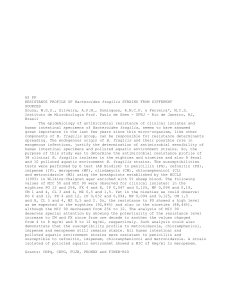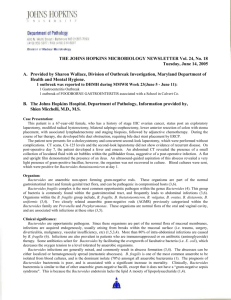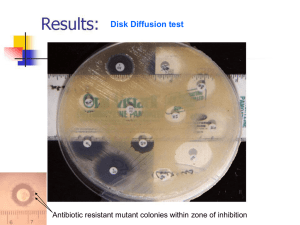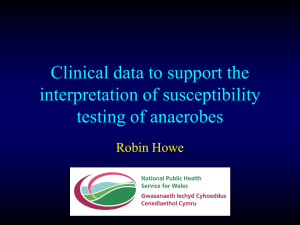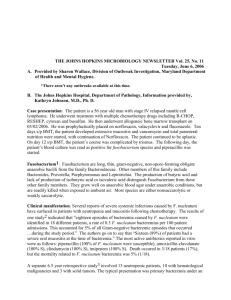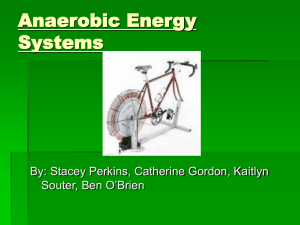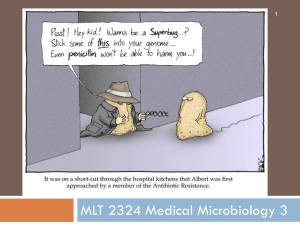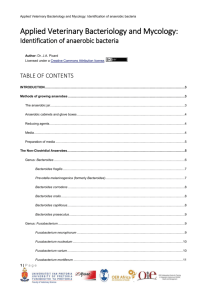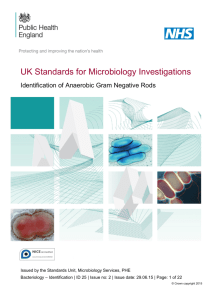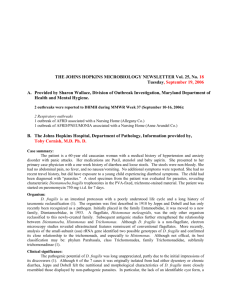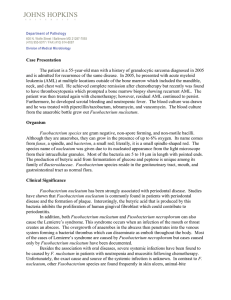AnaerobicCulture
advertisement
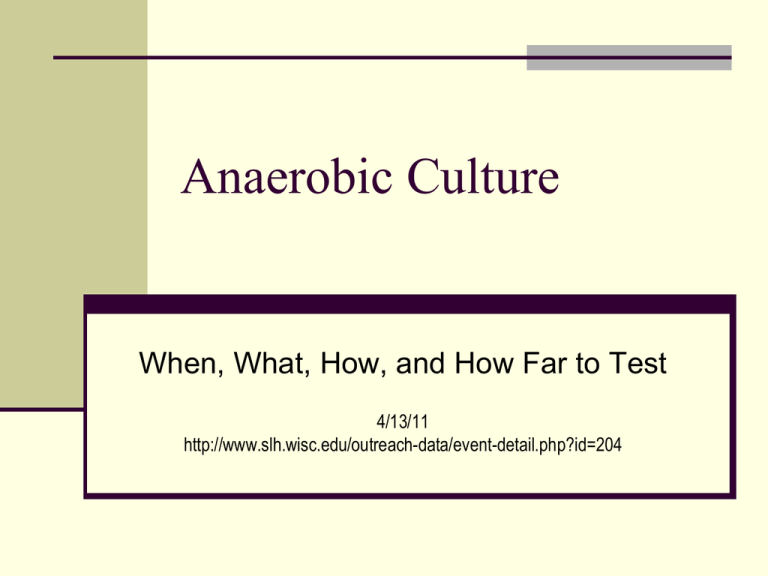
Anaerobic Culture When, What, How, and How Far to Test 4/13/11 http://www.slh.wisc.edu/outreach-data/event-detail.php?id=204 What is an anaerobe? Obligate “growth in the absence of O2 but fail to multiply in the presence of O2 on the surface of nutritionally adequate solid media incubated in room air or in a CO2 incubator (5-10% CO2 in air), e.g., C. haemolyticum, C. novyi type B, oral treponemes Moderate obligate can grow at O2 level averaging 3%, e.g., B. fragilis group, C. perfringens > Prevotella, Porphyromonas, Fusobacterium Aerotolerant can grow in a CO2 incubator, e.g., C. tertium, C. histolyticum, C. carnis 2 How to recognize the anaerobes Enriched (Columbia blood agar) Chocolate agar Reducible blood agar + + + + + O2 CO2 + + + ANO2 3 What specimens are appropriate for anaerobic culture? Sources of anaerobes Environment soil, marshes, lake and river sediments, ocean, sewage, food and animals Endogenous flora oral cavity (gingival crevice, tonsillar crypts) gastrointestinal tract (exp. colon) genitourinary tract skin 4 Endogenous flora – Gram negatives Oral B. fragilis group Prevotella and Bacteroides spp. √ Porphyromonas √ Fusobacterium √ Veillonella √ Large Female Male Skin bowel GU GU √ √ √ √ √ √ √ √ √ 5 Endogenous flora – Gram positives Oral Large Female Male Skin bowel GU GU Anaerobic cocci √ √ √ √ √ Propionibacterium √ √ √ √ √ Actinomyces √ √ Lactobacillus Eubacterium √ Bifidobacterium √ √ 6 Sources of infection by endogenous flora Oral Brain abscess, chronic sinusitis, lung abscess (aspiration) GI Sub diaphragmatic, hepatic, and sub hepatic abscess. Abdominal post trauma, post surgery, malignancy, ruptured viscus. Perirectal, necrotizing fasciitis, gas gangrene, C. difficile colitis Female Endometritis, post-abortal, tuboovarian GU abscess, post hysterectomy Skin CNS shunts, post orthopedic surgery Any Sepsis, endocarditis 7 Characteristics of anaerobic infections adjacent to mucous membranes mixed flora on Gram stain foul odor gas in tissue 8 Sources of infection by exogenous flora Culture plays a role in diagnosis Gas gangrene C. perfringens, C. novyi, C. septicum and others bite wounds intravenous drug abuse septic abortion Culture not generally used in diagnosis C. difficile nosocomial C. botulinum foodborne, wound, infant C. tetani tetanus C. perfringens gastroenteritis (food poisoning) 9 Appropriate sites Specimens from sites uncontaminated by skin or mucous membrane flora should be cultured for anaerobes sterile body fluids (blood, synovial, pleural, pericardial, CSF shunts, etc. Urine only if suprapubic tap.) aspirates from closed abscesses FNA and tissue biopsies AND antimicrobial therapy will be given Intraabdominal sepsis? 10 Intraabdominal sepsis Community acquired, mild-moderate do not culture Community acquired, severe/high risk/immunocompromised order Gram stain and aerobic culture Anaerobic culture not recommended as empiric therapy is used and TAT too long. CID 50:133-164, 2010 11 Inappropriate sites (not all inclusive) throat or NP swabs gingival or tongue swabs or extracted teeth sputum or BAL GI contents (gastric, small bowel, feces, rectal swabs, fistulae, stoma), perirectal abscesses surface swabs, e.g. decubitus ulcers sites adjacent to skin or mucous membranes that have not been properly decontaminated. urine (voided, catheter collected, cystoscopy) vaginal, cervical, urethral secretions IUD 12 Media for isolation of anaerobes Anaerobic blood agar Columbia, Schaedler, CDC, Brucella, Nonselective brain heart infusion, w/5% Sheep, YE, (enriched) Vitamin K1, hemin Bacteroides Bile Esculin TSA, ferric ammonium citrate, hemin, bile salts, gentamicin selective & differential for B. fragilis group Laked blood kanamycin vancomycin Brucella base with 5% laked blood, kanamycin & vancomycin selective for Bacteroides and some Prevotella Phenylethyl alcohol nutrient agar, 5% blood, PEA inhibits enteric GNR and swarming of some clostridia Egg-yolk agar egg yolk base lipase & lecithinase production Chopped meat/ thioglycollate meat particles/casein, soy, glucose, agar, vitamin K1, hemin nonselective, enrichment broths13 Anaerobic gram-negative rods Bacteroides fragilis group Bacteroides ureolyticus Bilophila wadsworthia Fusobacterium nucleatum Fusobacterium necrophorum 14 Anaerobic gram-negative rods Sutterella ALN, L-alanyl-L-alanyl-β-naphthylamide 15 Bacteroides fragilis group 16 B. fragilis group resistant to penicillin, colistin, bile, kanamycin, vancomycin BBE 17 Pigmented Prevotella and Porphyromonas species as above brick red fluorescence black pigment 18 Bacteroides urealyticus kanamycin, colistin and bile susceptible pits the agar urease positive asaccharolytic (requires formate-fumarate) 19 Bilophila wadsworthia bile resistant kanamycin and colistin susceptible vancomycin resistant black center in colony on BBE urease positive 20 Fusobacterium species Bile Lipase Indole Nitrate Gram stain FIID S - + - Pointed rod F. nucleatum SR +- + - Pleo rod F. necrophorum R - - - Pleo rod F. mortiferum R - + - Pleo rod F. varium 21 Lipase 22 Anaerobic gram-positive cocci Former Current Peptostreptococcus anaerobius Peptostreptococcus anaerobius P. magnus Finegoldia magna P. micros Micromonas micros P. asaccharolyticus Peptoniphilus asaccharlyoticus P. prevotii Anaerococcus prevotii P. tetradius Anaerococcus tetradius Peptococcus niger Peptococcus niger Staphylococcus saccharlyoticus Peptococcus saccharolyticus Other genera: Atopobium, Coprococcus, Gallicola 23 Identification of anaerobic grampositive cocci If susceptible (>12 mm) to sodium polyanethol sulfonate (SPS) = P. anaerobius Generic identification Peptostreptococcus species or ‘anaerobic gram-positive coccus formerly known as Peptostreptococcus species.’ 24 Anaerobic gram-negative cocci Veillonella species susceptible to kanamycin, colistin and bile brick red fluorescence Acidaminococcus Megasphaera Nitrate Vanco Identification + R Veillonella species probable - S/R Possible Prevotella/Porphyromonas + S Possible overdecolorized gram-positive cocci 25 Identification of common nonswarming clostridia Species Lecithinase Lipase Indole Urease C. bifermentans + - + - C. perfringens + - - - C. sordelii + - + + Other DZ hemolysis 26 Clostridium perfringens box car-like gram-positive rods DZ β-hemolysis no WBC α-toxin (an exotoxin) is lecithinase 27 Identification of swarming clostridia Species Lecithinase Lipase Indole Urease Other C. novyi A + + - - β-hemolytic C. septicum - - - - Rare spores C. sporogenes - + - -+ Abundant oval spores C. tetani - -w V - Terminal spores 28 Nonsporing gram-positive rods Actinomyces only A. viscosus may be catalase positive Bifidobacterium Eggerthella lenta Eubacterium Lactobacillus Propionibacterium P. acnes – indole (most) and catalase positive 29 When to perform susceptibility testing (CLSI M11-A7, 2007) Sites brain abscess endocarditis osteomyelitis joint infection prosthetic devices bacteremia Organisms B. fragilis group Bacteroides Prevotella Fusobacterium Clostridium Bilophila Sutterella (formerly B. gracilis and others) 30 Antibiotics with anti-anaerobe activity ampicillin amoxacillin-clavulanic acid; ampicillin-sulbactam cefoxitin, cefotetan cefotaxime, ceftriaxone, cefoperazone, cefmetazole, ceftizoxime chloramphenicol clindamycin imipenem, meropenem, ertapenem metronidazole mezlocillin moxifloxacin penicillin piperacillin, piperacillin-tazobactam tetracycline ticarcillin, ticarcillin-clavulanic acid 31 Susceptibility testing methods agar dilution broth dilution (for only B. fragilis group) Etest β-lactamase Cefinase NOT disk diffusion disk elution 32 Case #1 16 year old girl who developed sore throat and fever 5 days prior to admission (PTA) 3 d PTA – headache, temp 104 F over the next 2 days abdominal pain, vomiting, leg pain, decreased urine output lives in Madison; traveled to CA, VE, ME; spends time with grandmother in Spring Green; no known tick bites 2 cats 33 Case #1 cont WBC 7.5 (45 N/12L/36B/3 meta) hemoglobin 11.8 platelets 56,000 monospot negative 1 blood culture drawn gram-negative rod growing only in anaerobic bottle at 12.8 hr 34 Identification ALN negative indole positive lipase positive Fusobacterium necrophorum penicillin 0.032 mcg/mL clindamycin 0.016 mcg/mL metronidazole 0.032 mcg/mL 35 Lemierre’s Disease acute jugular vein septic thrombophlebitis often complicated by sepsis and metastatic abscesses, especially lungs, pleural space, liver and large joints life-threatening infection prolonged treatment 36 Case #2 53 y/o man with HCV, peripheral vascular disease, portal hypertension, hyperlipidemia and rectosigmoid carcinoma had resection of CA with anastamosis and was discharged home on hospital day 7 8 days later he developed fever, sweats and LLQ pain. CT scan showed an abscess in the posterior pelvis. The abscess was drained and aerobic and anaerobic cultures performed. Organisms recovered - E. coli, Bacteroides fragilis, Clostridium septicum 37 Clostridium septicum Clostridia are 2nd to Bacteroides among anaerobic blood culture isolates risk factors for C. septicum: neoplastic disease especially in ileocecal region or leukemia; inflammatory bowel disease (e.g. Crohn’s); cyclic neutropenia; cirrhosis 38 Also see CLSI M35-A2 Abbreviated identification of bacteria and yeast; Approved guideline, second edition Thank you! Carol A. Spiegel, Ph.D. Director, Clinical Microbiology University of Wisconsin Hospital & Clinics ca.spiegel@hosp.wisc.edu 39
